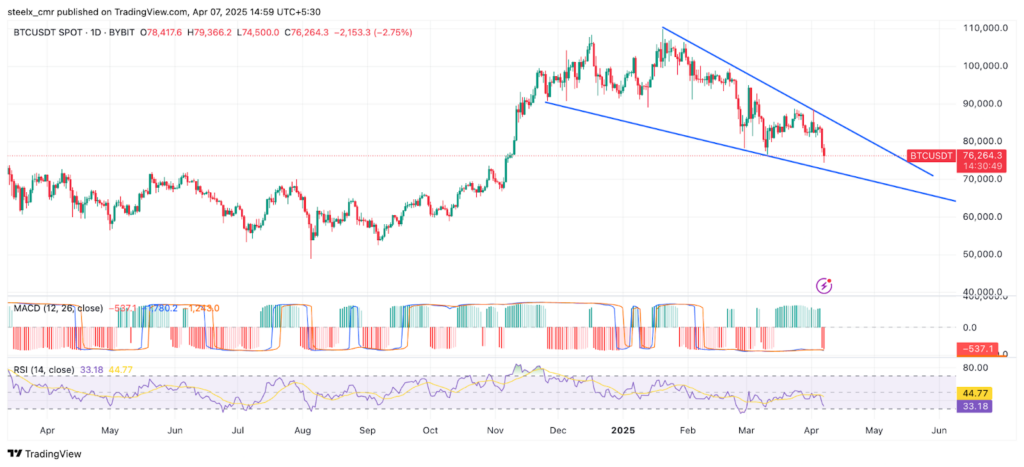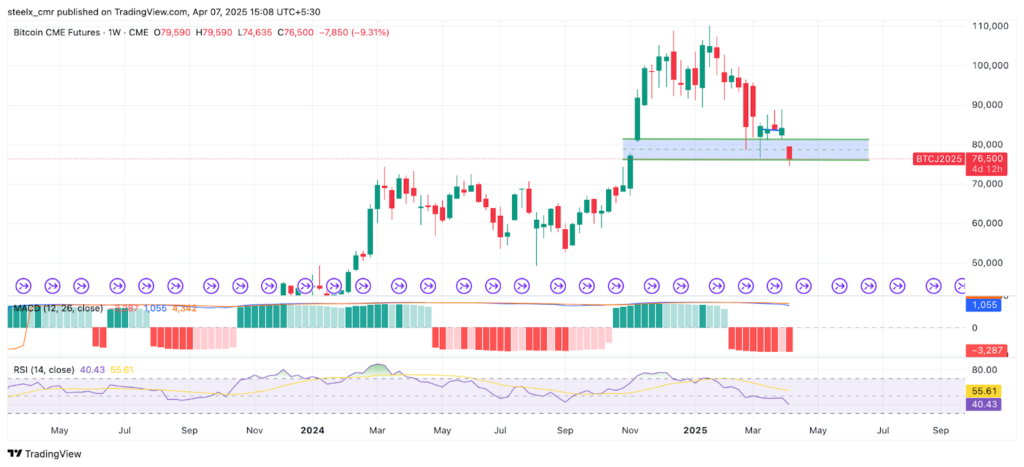
Bitcoin (BTC) is the world’s first and most valuable cryptocurrency. Known for its decentralized nature and limited supply, BTC serves as a store of value and a medium of exchange. With increasing institutional adoption, Bitcoin has become a major player in both the crypto and traditional financial markets.
Use Cases and Utility:
- Bitcoin facilitates peer-to-peer transactions, allowing users to send and receive payments globally without the need for intermediaries like banks.
- Often referred to as “digital gold,” Bitcoin is considered by many as a hedge against inflation and currency devaluation due to its limited supply of 21 million coins.
- By enabling transactions without traditional banking infrastructure, Bitcoin offers financial services to unbanked populations worldwide.
Bitcoin Current Price Overview
As of April 7, 2025, Bitcoin (BTC) is trading at approximately $76,326 USD or ₹65,03,776 INR.
Tokenomics
- Total Supply: 19.84 Million BTC
- Circulating Supply: 19.84 Million BTC
- Max Supply: 21 Million BTC
BTC Price Prediction Based on Technical Analysis

Chart Pattern Analysis

- Falling Wedge Pattern (1-Day Chart): Bitcoin is currently consolidating inside a falling wedge, a bullish reversal pattern that typically signals a potential breakout to the upside.
- CME Gap Filled: BTC has filled the previous CME gap at the $76,000 level.
- New CME Gap Above: A fresh CME gap has formed in the $79,000 to $82,500 zone, which may act as a price magnet in the short term.
Key Levels to Watch
- Resistance Levels:
- $78,500 – Top of the wedge; breakout above could signal bullish continuation.
- $82,500 – Upper end of the CME gap; major psychological resistance.
- $78,500 – Top of the wedge; breakout above could signal bullish continuation.
- Support Levels:
- $74,500 – Immediate support within the wedge.
- $72,000 – Key support zone; breakdown may lead to a bearish pullback.
- $74,500 – Immediate support within the wedge.
Recent Developments & Market Momentum
Price Volatility Amid Tariff Announcements
In early April 2025, Bitcoin’s price witnessed sharp fluctuations following President Donald Trump’s announcement of sweeping global tariffs. On April 7, Bitcoin’s value dropped below the $80,000 mark, reaching approximately $79,000, a 5% decline from previous levels. This downturn mirrored broader market reactions, with U.S. stock futures also plunging amid escalating trade tensions.
The tariffs, which apply to all imports and include additional duties on major trading partners, have raised fears of a potential global trade war. This uncertainty has prompted investors to divest from riskier assets, including cryptocurrencies.
Bitcoin Hashrate Reaches All-Time Highs
Despite market volatility, Bitcoin’s network hashrate—a measure of the total computational power securing the network—has reached unprecedented levels. On April 4, 2025, the hashrate hit an all-time high of 1,105.68 exahashes per second (EH/s).
This surge in hashrate indicates robust miner participation and confidence in the network’s long-term viability. A higher hashrate enhances the security and resilience of the Bitcoin network, making it more resistant to potential attacks. The increase can be attributed to advancements in mining hardware and favorable policies aimed at supporting the cryptocurrency industry.
Bitcoin Fundamentals for Long-Term Price Prediction
| Aspect | Details | Evaluation |
| Utility | Store of value, payment method, digital asset | Strong |
| Market Position | Leading global cryptocurrency | Dominant |
| Community | Global adoption and robust development ecosystem | Massive |
| Tokenomics | Scarce supply with predictable issuance schedule | Excellent |
| Adoption | Growing institutional and retail investor base | Expanding |
BTC Price Targets from 2025 to 2030
| Year | Bearish Case (USD) | Bullish Case (USD) | Remarks |
| 2025 | $68,000 | $125000 | Halving impact and ETF inflows |
| 2026 | $95,000 | $130,000 | Broader institutional adoption |
| 2027 | $125,000 | $180,000 | Bitcoin as global inflation hedge |
| 2028 | $160,000 | $220,000 | Decreased volatility, mainstream usage |
| 2029 | $190,000 | $270,000 | Central bank reserves integration |
| 2030 | $225,000 | $350,000 | Widespread adoption, supply peak near |
Yearly Price Prediction Breakdown
- 2025 Prediction: Driven by steady ETF inflows, potential US rate cuts, and a shift toward quantitative easing, Bitcoin could rally within the $68,000–$125,0000 zone as macro conditions and institutional demand align.
- 2026 Prediction: Institutional confidence is expected to grow, with more corporations and asset managers adding Bitcoin to their reserves and balance sheets. This broader adoption, combined with a maturing regulatory landscape and increased integration of Bitcoin into traditional financial systems, could help lift BTC into the $95K–$130K range.
- 2027 Prediction: By 2027, Bitcoin’s price could reach the $125K–$180K zone as it benefits from accelerating global adoption—both as a digital store of value and as collateral in decentralized finance and traditional markets. Sovereign wealth funds and pension institutions may begin allocating small percentages to Bitcoin, further legitimizing it as a long-term asset.
- 2028 Prediction: The 2028 Bitcoin halving could play a key role in driving prices into the $160K–$220K range by reducing new supply at a time when demand from institutions and sovereign entities continues to rise. This supply shock, paired with Bitcoin’s growing role as a macro hedge and long-term store of value, could push it into a new valuation tier.
- 2029 Prediction: Historically, Bitcoin has seen its strongest rallies in the 12–18 months following a halving event. By 2029, the effects of the 2028 halving could be in full swing, with reduced supply colliding with sustained institutional demand. This post-halving momentum, combined with growing market maturity and increased global exposure, could propel BTC into the $190K–$270K range as part of its cyclical price expansion.
- 2030 Prediction: By 2030, Bitcoin could begin to seriously rival gold’s market share as a global store of value. With growing institutional conviction, increased sovereign adoption, and a generation of investors more comfortable with digital assets, Bitcoin may command a larger portion of capital traditionally allocated to gold. If BTC captures even a fraction of gold’s multi-trillion-dollar market, its valuation could rise significantly—potentially reaching the $220K–$320K zone as it cements its status as “digital gold.”
Conclusion
Bitcoin continues to lead the cryptocurrency market as both a premier investment asset and a pillar of financial innovation. While short-term volatility may arise from geopolitical tensions and policy shifts—such as Donald Trump’s proposed reciprocal tariffs—the long-term fundamentals remain firmly intact. With growing institutional adoption and increasing scarcity post-halving, Bitcoin is well-positioned for potential new highs in the coming years. Despite near-term turbulence, BTC remains one of the most compelling long-term holds in the digital asset space.





